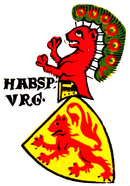Landsberg rule
The rule of Landsberg near Colmar in Alsace existed from the 13th to the 17th century.
Administrative headquarters
The administrative seat of the Landsberg estate was at Hohlandsberg Castle , which was built in 1279 at the instigation of King Rudolf von Habsburg by the Vogt of Colmar, Siegfried von Gundolsheim .
scope
The rulership, owned by the Habsburgs since 1281 , comprised nine villages: Kientzheim , which became a residence from 1303, as well as Ammerschwihr , Ingersheim , Katzenthal , Meywihr , Niedermorschwihr , Sigolsheim , Turckheim and Wintzenheim .
history
The rulership originally belonged to a family that named itself after the Landsberg rulership. In 1234 a Günther von Landsberg appears who, together with his wife Belina and his children, handed over their goods to Guebwiller to brother Gotfrid, the master of the Teutonic Knight Order in Rouffach . In 1279, Siegfried von Gundolsheim began expanding Hohlandsberg Castle. A short time later, in 1281, the rule fell to the lords of Habsburg, who built the fortress there on a large scale.
The Hohlandsburg was the official capital of the Bailiwick, but lost its function as the administrative seat in the 15th century and was pledged to noble families by the Habsburgs on various occasions. In 1363, Duke Rudolf IV of Austria sold the fiefdom of the castle and the lordship for 1000 florints to the three brothers Rappoltstein (Ribeaupierre) , who were based in Rappoltsweiler . In 1398, castle and rule came to Count Johann von Lupfen , whose family held the fief until 1563 , through the marriage of Herzlaude von Groß-Rappoltstein, daughter of Ulrich VII zu Groß-Rappoltstein and Hohenack and officially regent since 1377 .
In 1563 the heirs of the Counts of Lupfen sold the rule to the imperial general and statesman Lazarus von Schwendi , who in 1568 was raised to the title of "Imperial Baron of Landsberg" by Emperor Maximilian II ; the title was changed in 1572 to "Reichsfreiherr von Hohenlandsberg". Schwendi gave the rule an exemplary order and promoted viticulture in Alsace and Breisgau . The places of Kientzheim, Sigolsheim, Ammerschwihr, Ingersheim and Wintzenheim as well as income from wine in Turckheim and other places in the area belonged to the Schwendisches Amt Hohenlandsberg. After Schwendi's death in 1583, he was followed by his son Hans Wilhelm († 1604) and then one of his granddaughters, who had married a Count von Fürstenberg .
- Ruler of Landsberg
Lords of Landsberg
until 1281Lords of Habsburg
1281–1363Lords of Rappoltstein
1363–1398Counts of Lupfen
1398–1563Lords of Schwendi
1563–1604
"Imperial Barons of Hohenlandsberg"Counts of Fürstenberg
1604–1697
Since the Peace of Rijswijk (1697), the Hohenlandsberg domain was also de jure French possession. King Louis XIV bought it in 1714 and left it to the city of Colmar to replace the St. Peters priory that had been taken from it.
Web links
- chateau-hohlandsbourg.com Homepage of Hohlandsberg Castle
Individual evidence
- ↑ ZGORh. Vol. 28, p. 88





